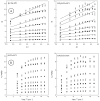Adsorption Properties of β- and Hydroxypropyl-β-Cyclodextrins Cross-Linked with Epichlorohydrin in Aqueous Solution. A Sustainable Recycling Strategy in Textile Dyeing Process
- PMID: 30960236
- PMCID: PMC6419267
- DOI: 10.3390/polym11020252
Adsorption Properties of β- and Hydroxypropyl-β-Cyclodextrins Cross-Linked with Epichlorohydrin in Aqueous Solution. A Sustainable Recycling Strategy in Textile Dyeing Process
Abstract
β-cyclodextrin (β-CD) and hydroxypropyl-β-cyclodextrin (HP-β-CD) were used to prepare insoluble polymers using epichlorohydrin as a cross-linking agent and the azo dye Direct Red 83:1 was used as target adsorbate. The preliminary study related to adsorbent dosage, pH, agitation or dye concentration allowed us to select the best conditions to carry out the rest of experiments. The kinetics was evaluated by Elovich, pseudo first order, pseudo second order, and intra-particle diffusion models. The results indicated that the pseudo second order model presented the best fit to the experimental data, indicating that chemisorption is controlling the process. The results were also evaluated by Freundlich, Langmuir and Temkin isotherms. According to the determination coefficient (R²), Freunlich gave the best results, which indicates that the adsorption process is happening on heterogeneous surfaces. One interesting parameter obtained from Langmuir isotherm is qmax (maximum adsorption capacity). This value was six times higher when a β-CDs-EPI polymer was employed. The cross-linked polymers were fully characterized by nuclear magnetic resonance (NMR), Fourier transform infrared spectroscopy (FTIR), thermal gravimetric analysis (TGA). Also, morphology and particle size distribution were both assessed. Under optimized conditions, the β-CDs-EPI polymer seems to be a useful device for removing Direct Red 83:1 (close 90%), from aqueous solutions and industrial effluents. Complementarily, non-adsorbed dye was photolyzed by a pulsed light driven advanced oxidation process. The proposed methodology is environmental and economically advantageous, considering the point of view of a sustainable recycling economy in the textile dyeing process.
Keywords: Direct Red; HP-β-CDs; adsorption; isotherm; kinetics; pulsed light; β-CDs.
Conflict of interest statement
The authors declare no conflict of interests.
Figures









References
-
- Kant R. Textile dyeing industry an environmental hazard. Nat. Sci. 2012;4:22–26. doi: 10.4236/ns.2012.41004. - DOI
-
- Maxwell D., McAndrew L., Ryan J. State of the Apparel Sector Report—Water. [(accessed on 21 December 2018)];2015 Aug; A Report for the Global Leadership Award in Sustainable Apparel. Available online: https://glasaaward.org/wp-content/uploads/2015/05/GLASA_2015_StateofAppa....
-
- WRAP Valuing Our Clothes: The Cost of UK Fashion. [(accessed on 21 December 2018)];2017 Available online: http://www.wrap.org.uk/sites/files/wrap/valuing-our-clothes-the-cost-of-....
-
- Copaciu F., Opris O., Coman V., Ristoiu D., Niinemets Ü., Copolovici L. Diffuse water pollution by anthraquinone and azo dyes in environment importantly alters foliage volatiles, carotenoids and physiology in wheat (Triticumaestivum) Water Air Soil Pollut. 2013;224:1478–1484. doi: 10.1007/s11270-013-1478-4. - DOI
-
- Kaya A., Yigit E., Akbulut G.B. The effects of Reactive black 5 textile dye on peroxidase activity, lipid peroxidation and total chlorophyll concentration of Phaseolus vulgaris L. cv. “Gina”. Fresen. Environ. Bull. 2012;21:54–60.
Grants and funding
LinkOut - more resources
Full Text Sources
Research Materials
Miscellaneous

